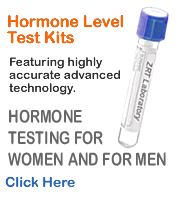|
|
||||
|
For suggestions on how to find a doctor in your area, please go to:  |
||||
|
Saliva Hormone Test Measures Progesterone Cream Absorption |
|||||||
SPECIAL REPORT from The John R. Lee, M.D. Medical Letter SALIVA VS. SERUM OR PLASMA TESTING FOR PROGESTERONE Confusion exists among medical professionals and the general public about the question of progesterone absorption. This confusion often hinges on a misunderstanding of the test used to measure progesterone levels in the body. Let us try to clarify the issue. In this report:
"Blood" tests for progesterone refer to the serum or plasma concentration of progesterone. Plasma is the watery, non-cellular portion of the blood from which cellular components such as red blood cells and white blood cells, are excluded. Serum is essentially the same as plasma except that fibrinogen has been removed. Serum and plasma, being watery, contain water-soluble (hydrophilic) substances such as water-soluble vitamins, carbohydrates, and proteins. Serum and plasma do not contain fat-soluble (lipophilic) substances. For the purposes of this discussion, serum and plasma are interchangeable and I will refer to them as serum. Sex hormones such as progesterone, estrogen and testosterone are fat-soluble steroids similar to cholesterol. When you have a serum cholesterol measurement, you are measuring cholesterol bound to protein, which makes it water-soluble. (Recall that serum cholesterol is described as HDL or LDL cholesterol, referring to the proteins to which it is bound.) How Progesterone Travels in Blood The ovary-produced progesterone found in serum is also largely protein-bound. Protein-bound progesterone is not readily bioavailable to receptors in target tissues throughout the body. It is on its way to the liver to be excreted in bile. Only 2 to 5 percent of serum progesterone is "free" or non-protein-bound. This is the progesterone available to target tissues and to saliva. Thus, progesterone measured by serum levels is mostly a measure of progesterone that is not going to be used by the body. A serum test can be used to compare one woman's progesterone production to that of another woman, or to test how much progesterone is being made by a woman's ovaries. When progesterone is given intravenously, 80 percent of it is taken up by red blood cell membranes that are fatty in nature and therefore available to fat-soluble progesterone molecules. Less than 20 percent will be found in serum. It is obvious that serum levels would not detect the great majority of the progesterone added to whole blood. Absorption of Transdermal Progesterone Progesterone is a highly lipophilic (fat loving) molecule that is well absorbed through skin into the underlying fat layer. In fact, it is among the most lipophilic of the steroid hormones. From the fat layer, the progesterone is taken up gradually by red blood cell membranes in capillaries passing through the fat. The progesterone transported by red blood cell membranes is readily available to all target tissues and to saliva. This progesterone is completely bioavailable and readily measured by saliva testing. Only a small fraction of it is carried by the watery serum. Obviously, serum testing is not a good way to measure transdermal progesterone absorption. Yet, many doctors continue to question the skin absorption of progesterone. A recent example is a report in the April 25, 1998 issue of the Lancet that serum levels did not reflect a substantial rise of progesterone after topical application in postmenopausal women. This report is being used to argue that progesterone is not well absorbed. This implication is erroneous. Rather, it means that the authors did not understand the significant difference between serum and saliva progesterone levels. Some even imply that saliva testing is relatively unknown and its reliability is unproven. This is an odd admission since researchers have been using saliva testing for years and a number of laboratories offer routine saliva hormone testing. A sampling of references supporting all points of importance in this matter can be found at the end of this report. How to Use Saliva Testing to Determine Progesterone Dosage Achieving Balance is the Key In my experience, the topical dose required to achieve a saliva level of 0.5 ng/ml is commonly only 12 to 15 mg per day. For creams containing 900 to 1000 mg per 2-oz container, 12-15 mg a day for 24 days would use up only about one-third of a 2-oz container. Larger doses are often used initially to "catch up" on the existing progesterone deficiency state, but the maintenance dose will usually be around 15 mg per day. Since considerable variation in progesterone is well tolerated, a modest elevation of saliva levels to 0.8 to 1.5 ng/ml is acceptable. Saliva progesterone levels several times higher than 0.5 ng/ml are justified in certain situations. In PMS, for example, stress is often a factor. Stress increases cortisol production. Cortisol blockades some progesterone receptors and thereby prevents progesterone function. To compete with this cortisol blockade, topical progesterone in the range of 30 to 40 mg/day is sometimes initially required to achieve a beneficial effect. Progesterone and Endometriosis Likewise, in women with endometriosis, the goal is to increase progesterone levels to that found in women two months pregnant. This level may require that supplemental topical progesterone be in a range of 30 to 50 mg/day from day 8 to day 26 of the menstrual cycle. (See the July 98 issue of the John Lee Medical Letter, for a more detailed article on the causes and treatment of endometriosis.) Progesterone dosage is determined largely by response: the right dose is the amount that results in progressive decrease of endometriosis pain. When pain is largely gone, levels can be decreased gradually over time to doses necessary to maintain the progesterone benefit. Progesterone and Estrogen Receptors In women whose doctors are giving them excessive supplemental estrogen, a different problem must be faced. Excessive estrogen in circumstances of deficient progesterone induces a decrease in receptor sensitivity. One of progesterone's functions is to restore the normal sensitivity of estrogen receptors. When progesterone is restored, estrogen receptor sensitivity is restored also. It is not surprising that, in these cases, some women develop symptoms of estrogen dominance (water retention, headaches, weight gain, swollen breasts) when progesterone is first supplemented. Obviously, the estrogen dose must be lowered. If this is done too rapidly, however, hot flushes can occur. The key is to reduce estrogen gradually while progesterone is being restored. In my experience, estrogen dosage can be reduced 50 percent as soon as progesterone is added. Then, every 2 to 3 months, the estrogen dose can be further decreased gradually. Many women eventually discover they do not need any supplemental estrogen at all. The estrogen normally produced by body fat in postmenopausal women is often sufficient for its needs once the progesterone is restored. Saliva Hormone Testing as Used by Researchers Painter-Brick C, Lotstein DS, Ellison PT. Seasonality of reproductive function and weight loss in rural Nepali women. Hum Reprod May 1993; 8 (5): 684-690. Ellison PT, Painter-Brick C, Lipson SF, O'Rourke MT. The ecological context of human ovarian function. Hum Reprod Dec 1993; 8 (12): 2248-2258. Ellison PT. Measurements of salivary progesterone. Ann NY Acad Sci Sept 20 1993; 694: 161-176. Campbell BC, Ellison PT. Menstrual variation in salivary testosterone among regularly cycling women. Horm Res 1992; 37 (4-5): 132-136. Lipson SF, Ellison PT. Reference values for luteal "progesterone" measured by salivary radioimmunoassay. Fertility and Sterility May 1994; 61 (3): 448-454. Bloom T, Ojanotko-Harri A, Laine M, Huhtaniemi I. Metabolism of progesterone and testosterone in human parotid and submandibular salivary glands in vitro. J Steroid Biochem Mol Biol Jan 1993; 44 (1): 69-76. Good Evidence Concerning the Absorption of Steroids Through Human Skin Johnson ME, et al. Permeation of steroids through human skin. J Pharmaceutical Sci 1995; 84: 1144-1146. The Evidence of Red Blood Cell Transport of Progesterone Devenuto F, et al. Human erythrocyte membrane: Uptake of progesterone and chemical alterations. Biochim Biophys Acta, 1969;193:36-47. Koefoed P, Brahm J. Permeability of human red cell membrane to steroid sex hormones. Biochim Biophys Acta 1994; 1195: 55-62. Direct Comparison of Plasma and Saliva Levels After Topical Progesterone Application Dollbaum CM, Duwe GF. Absorption of progesterone after topical application: plasma and saliva levels. Presented at the 7th Annual Meeting of the American Menopause Society, 1997. The last reference is particularly revealing. Creams with varying concentrations of progesterone were applied to menopausal women after which both plasma and saliva levels were measured. The results are illustrated below.
As can be seen, in these menopausal women given the placebo topical cream, the plasma level was more than 10 times greater than saliva level. This indicates how little of their blood progesterone was of the non-protein-bound, bioavailable kind. When only 0.34 mg of progesterone was applied topically, the plasma level rose 39 percent, whereas saliva level rose 5-fold. This indicates that only a small portion of the added progesterone entered the plasma, whereas the saliva clearly showed a hefty increase of bioavailable progesterone. When an 88-fold larger dose was applied topically, the plasma level rose only 3.6-fold while the simultaneous saliva level rose 57-fold. This indicates that only the saliva reflected the great increase in absorbed bioavailable progesterone. The progesterone found in the saliva obviously was blood-borne, but it should be clear that the portion of the blood carrying the progesterone was not the plasma (serum) but, rather, was via red blood cells. In all situations, however, it should be clear that plasma progesterone levels are not indicative of the true level of bioavailable progesterone such as is obtained from topical application. Saliva levels are far more appropriate for this purpose. DO YOU NEED A SALIVA HORMONE TEST?
|
|||||||




